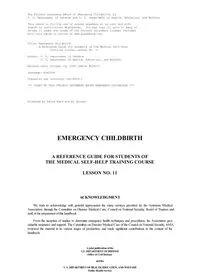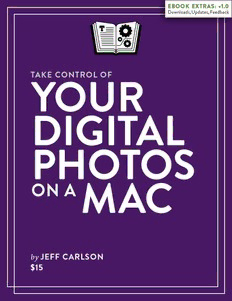
Take Control of Your Digital Photos on a Mac PDF
Preview Take Control of Your Digital Photos on a Mac
EBOOK EXTRAS: v1.0 Downloads, Updates, Feedback TAKE CONTROL OF YOUR DIGITAL PHOTOS ON A MAC by JEFF CARLSON $15 Table of Contents Read Me First ...............................................................4 Updates & More ............................................................. 4 Basics ......................................................................... 5 Introduction .................................................................6 Digital Photos Quick Start ............................................8 Shoot Smarter ............................................................10 Check & Set the Clock ...................................................10 Clear the Memory Card .................................................. 12 Choose a Format ..........................................................12 Geotag Your Photos ...................................................... 15 Choose the Right Photo-management Application .....17 iPhoto ........................................................................ 19 Aperture .................................................................... 22 Photoshop Lightroom .................................................... 24 Photoshop Elements ..................................................... 27 Jeff’s Recommended Application ......................................29 Import Your Photos ....................................................30 Apply Metadata at Import .............................................. 31 Choose Where Files Will End Up ...................................... 36 Auto-upload Services .................................................... 39 Understand Auto-organizing Schemes .............................. 40 Judge Your Photos .....................................................43 Develop a Consistent Rating System ................................ 44 Cull Bad Photos ........................................................... 48 Assign Keywords & Other Metadata ...........................53 Assign Metadata .......................................................... 53 Fix Incorrect Dates ....................................................... 62 Apply Geotags ............................................................. 65 2 Skip Facial Recognition .................................................. 77 Organize Photos into (Smart) Albums ........................78 Locate Your Photos Using Search ..................................... 78 Get Smart about Albums ............................................... 86 Back Up & Archive Photos ..........................................98 Back Up Your Photos .....................................................99 Archive Photos for the Future ........................................ 108 Migrate Photos to a Different App ............................111 iPhoto to Aperture ...................................................... 112 iPhoto to Lightroom .................................................... 113 Aperture to Lightroom ................................................. 127 About This Book ....................................................... 129 Ebook Extras ............................................................. 129 About the Author ........................................................130 About the Publisher ................................................ -PAGE- Copyright & Fine Print .............................................. 133 Featured Titles ......................................................... 134 SizzlPix! Coupon .......................................................135 3 Read Me First Welcome to Take Control of Your Digital Photos on a Mac, version 1.0, published in September 2013 by TidBITS Publishing Inc. This book was written by Jeff Carlson and edited by Kelly Turner. This book gives Mac users the information they need to build and maintain a digital photo workflow that makes it easy to import, tag, rate, and store photos to find them quickly and easily later. It helps you spend more time on the enjoyable aspects of photography— shooting and viewing your photos—and less on the mundane but essential task of managing all your photos. If you want to share this ebook with a friend, we ask that you do so as you would with a physical book: “lend” it for a quick look, but ask your friend to buy a copy for careful reading or reference. Discounted classroom and Mac user group copies are available. Copyright © 2013, Jeff Carlson. All rights reserved. Updates & More You can access extras related to this ebook on the Web (use the link in Ebook Extras, near the end; it’s available only to purchasers). On the ebook’s Take Control Extras page, you can: • Download any available new version of the ebook for free, or buy any subsequent edition at a discount. • Download various formats, including PDF, EPUB, and Mobipocket. (Learn about reading this ebook on handheld devices on our Device Advice page.) • Read postings to the ebook’s blog. These may include new tips or information, as well as links to author interviews. At the top of the blog, you can also see any update plans for the ebook. 4 If you bought this ebook from the Take Control Web site, it has been added to your account, where you can download it in other formats and access any future updates. However, if you bought this ebook elsewhere, you can add it to your account manually; see Ebook Extras. Basics Here are a few fundamentals that will help you read this ebook: • Links: All blue text in this ebook is hot, meaning you can click (or tap) it, just like a link on the Web. If you click a link to switch to a different part of the ebook, you can return quickly to where you were if your ebook reader offers a “back” feature. For example, if you use iBooks in iOS to read the EPUB version of this ebook, you can tap the “Back to” link at the lower left of the screen. Or, if you use Preview on the Mac to read the PDF version of this ebook, you can choose Go > Back or press Command-[. • Menus: Where I describe choosing a command from a menu in the menu bar, I use an abbreviated description that puts the name of the menu ahead of the command. For example, at the end of the previous paragraph, “Go > Back” means “choose the Back command from the Go menu.” 5 Introduction You probably have a story like this. My mother recently took it upon herself to organize and digitize the family’s long-neglected stash of photos. Prints were pulled from proverbial shoeboxes, albums, and envelopes tucked in the backs of drawers. Black and white, sepia-tone, color; yellowed by age and old chemical processes; worn at the edges and vignetted in ways that today’s apps try so hard to emulate digitally. Most details of the people and places in the pictures were lost or had changed over time, but she had an advantage: flipping the photos over often revealed valuable information about the shots, usually scribbled in pencil as an afterthought because the photographer or family member at the time knew who and what was depicted. As we’ve embraced the digital photography revolution, there is nothing to flip over. The shots we capture are saved to memory cards and hard drives, and are infrequently printed. And we’re shooting more. It’s now far easier to take photos because decent-quality cameras are inexpensive and pocketable. Top-rate camera technology is embedded into most cell phones; the iPhone, in fact, currently ranks as the most popular camera at the photo-sharing site Flickr. As a result, we’re drowning. No longer restricted by the length of frames on a film roll or the expense of paying to develop the bad shots along with the good, we capture many more photos. But then what? Too often, the shots are dumped into a computer with the best of intentions of sorting and organizing, but are then left scarcely examined or enjoyed. Life intrudes, more photos are captured, and time passes until you need to locate some shots that you vaguely remember taking. 6 This is the point where you ask yourself, often in exasperation, “Why didn’t I organize these better? This shouldn’t be so difficult!” And here’s where the new story begins. Taking control of your digital photos isn’t impossible. Although we have more photos to deal with, we also have much better tools to describe and organize them. In fact, your camera and photo- management software can do some of the heavy lifting for you. By taking some deliberate steps before you go out shooting and when you import the images, you’ll streamline what is normally a time- consuming task—making it all the more likely that you’ll actually do it. Best of all, you’ll be able to find images later without having to scan through every single shot in your library. You’ll be able to “flip” the photos over and get all the information you need. The process I describe in Take Control of Your Digital Photos on a Mac stakes out the middle ground between a completely hands-off approach (letting the software organize imported photos by time and date alone) and the labor-intensive, detail-oriented approach taken by some professional photographers. Although my approach embraces the liberal use of keywords and other metadata, it also focuses on saving time and reducing complexity to ensure you develop a system you’ll really follow through on each time. (By the way, many of these techniques apply to the ever-increasing number of videos in your library, too.) For those who would like to spend even less time managing photos, I offer some suggestions for modifying the process throughout the book. 7 Digital Photos Quick Start Here’s a quick overview of my recommended strategy, complete with links to different topics in the ebook, so you can jump to them quickly. Prep your camera: A bit of preparation before you head out the door will make things easier after you return with new pictures. In Shoot Smarter, learn four actions that will get you started on the right footing. Get your app together: • Decide which application you’ll use to organize your digital photos in Choose the Right Photo-management Application. • Compare four common choices and find out about Jeff’s Recommended Application. • If you currently use iPhoto, but would like to switch to a different tool, read Migrate Photos to a Different App. Import the right way: • Many people rush through the process of importing photos from a camera or memory card into the computer. However, this step is essential: see Apply Metadata at Import to learn how to assign, in one batch, valuable metadata to all images that come in during the import stage. Let the computer do the work for you! • I also talk about Auto-upload Services like Dropbox and iCloud Photo Stream, and help you Understand Auto-organizing Schemes like iPhoto’s events. Pick winners and losers: • Not every photo you take can be a winner, so the next step to a more manageable library is to Judge Your Photos and assign ratings. • Just as important: take a deep breath and Cull Bad Photos by removing or hiding them. 8 Apply keywords and metadata: • After assigning as much metadata as you can during the import process, take a second pass to apply more specific keywords to individual shots (see Assign Keywords & Other Metadata, and don’t miss my advice on how to Choose Good Keywords). • If you used an external device such as an iPhone to collect GPS data while shooting, Apply Geotags shows how to merge that information with your photos. Search with smart albums: A large virtual pile of photos, even organized by date, can still be an imposing mass (and mess). I recommend you Organize Photos into (Smart) Albums—containers that look like regular photo albums but whose contents change depending on criteria that you specify. Using smart albums is like having a photo assistant who can dig through your archives to find what you want in a matter of seconds. Protect your photos: • All this work is for nothing if a failing hard drive wipes out the one and only copy of your photo library. You absolutely, without question need to Back Up & Archive Photos with a backup strategy that backs up all your data, not just your photos. • Since there’s no guarantee the software you use today will function in 10 or 20 years, I talk about how to Archive Photos for the Future. The harried photographer: Sometimes, you may not find it possible to hit every step in the system I recommend. For those who find that too much complexity results in paralysis, or who face years and years of unmanaged photos, I lay out the bare minimum of how to get organized in a hurry. See The Harried Photographer: Keywords and Metadata, The Harried Photographer: Rating Photos, and The Harried Photographer: Organization. But keep in mind that you may end up just time-shifting some of the work— applying keywords later, for example, or spending more time scanning through your library for that “one” shot. 9 Shoot Smarter It’s easy to think that taking control of digital photos begins when you import the images into your computer, but the truth is that the process starts before you capture your first shot. For example, time stamps are the foundation of photo-management software, making it essential that your camera records the correct time. It is possible to fix errant time stamps later, but doing so throws a roadblock into your workflow. (And if enough roadblocks appear, you may decide to turn around and abandon the endeavor altogether.) The advice in this section isn’t complicated, but it goes a long way toward ensuring the photos you shoot will be cleanly imported. Check & Set the Clock How many digital clocks do you set on a regular basis? These days the number is small because our devices—computers, smartphones, iPads, even some televisions—configure the date and time automatically by getting the info from the Internet. When Daylight Saving Time (DST) switches over, I need to change only a few holdovers such as the clock on my oven and an analog clock above the fireplace. Oh, and my cameras. Although they include options for indicating whether DST is on or off, I mistakenly assume that because they’re also computers (specialized computers, that is) they inherit the correct time when it changes. And every spring and autumn I invariably forget to change one, resulting in imported photos that appear in my library shifted by one hour. That may not seem like a big deal, but if you then also import images from a properly set camera—such as an iPhone— you’ll end up with photos jumbled out of order. Time and date stamps are the most crucial methods of organizing photos, so it’s important to get that information correct before you start shooting. When you travel to a new time zone, make a point of 10
The list of books you might like

What Happened to You?

The Subtle Art of Not Giving a F*ck

As Good as Dead

Atomic Habits James Clear
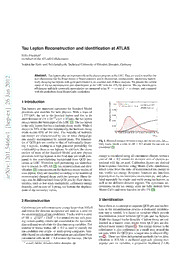
Tau Lepton Reconstruction and Identification at ATLAS

Greek Government Gazette: Part 2, 1993 no. 615

By Magic Alone

What's Bred in the Bone by Grant Allen

ultimate traffic Live User Guide

Kalyana Kalpataru Gita-tattva No Ii

Access 2013: The Missing Manual

C anton (©bsferVitr
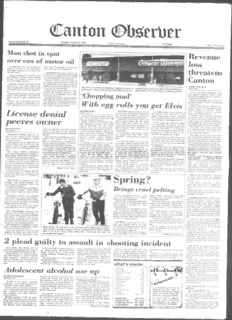
C anton O bsierber

C anton €>bserUer Supporters to lobby for airport purchase
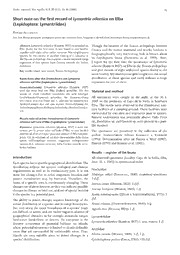
Short note on the first record of Lymantria atlantica on Elba

C anton €>bSerUer Board OKs 3 officer spots; new dispatch
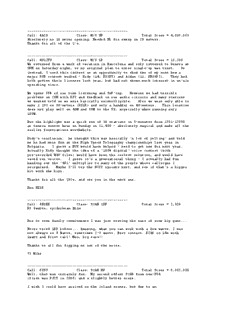
Call: 4A2S Class: M/S HP Total Score = 4839663 Absolutely no 10 mete

Lutheran Education Mar/Apr 1993

DC 1:2012cv00139 complaint attachment 5

Guerra Contra Todos los Puertorriqueños: Revolución y Terror en la Colonia Americana (Spanish Edition)

